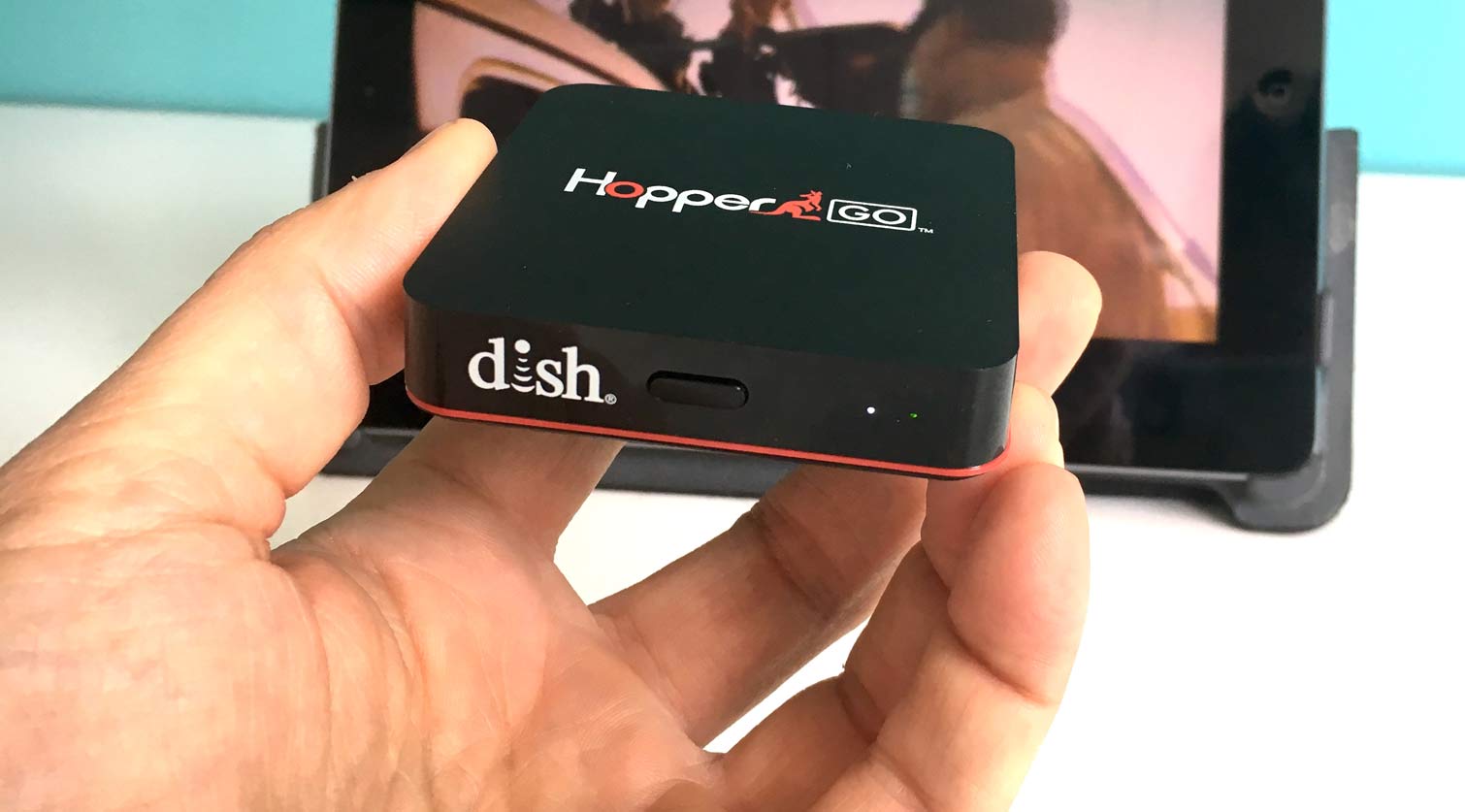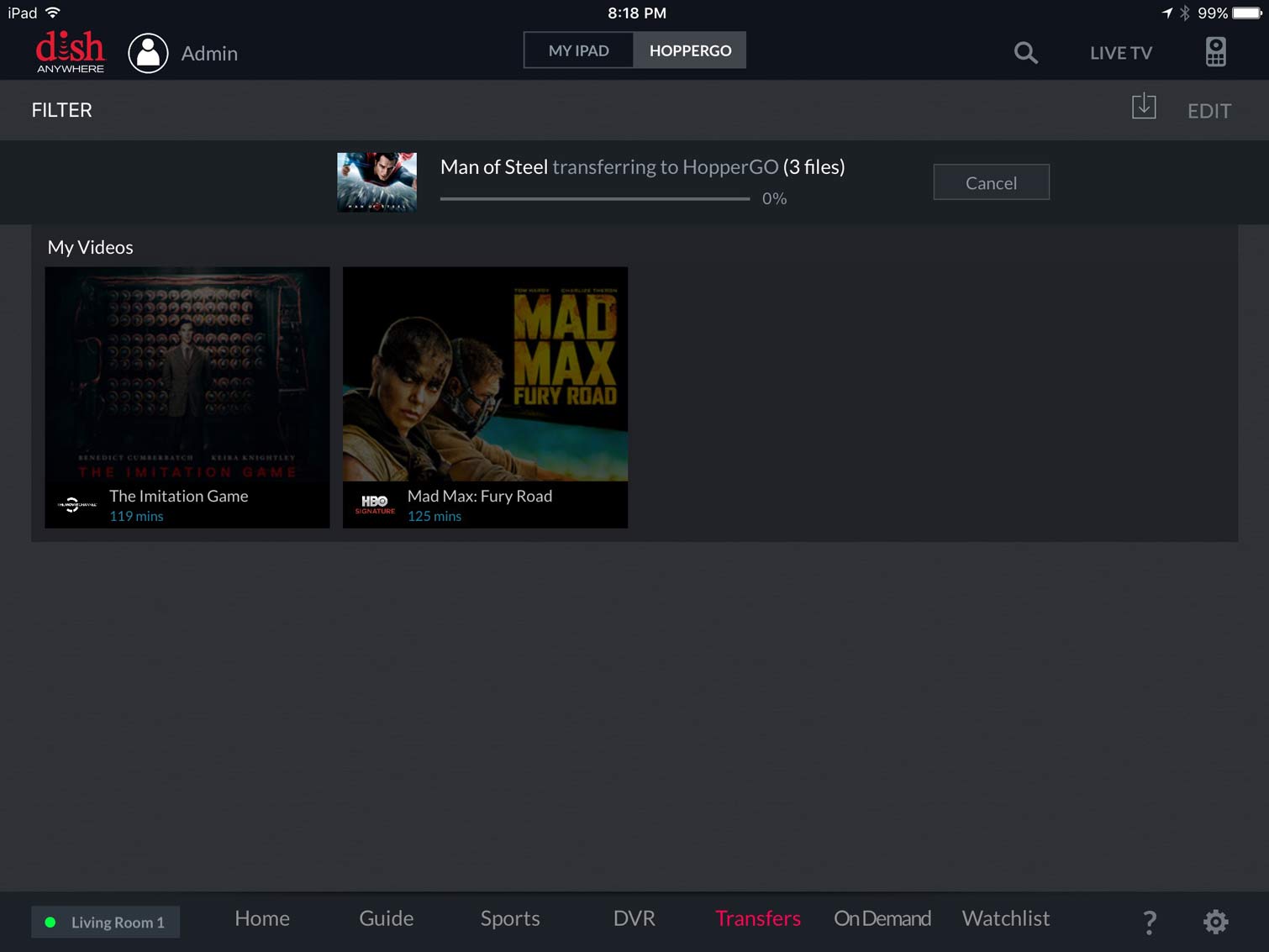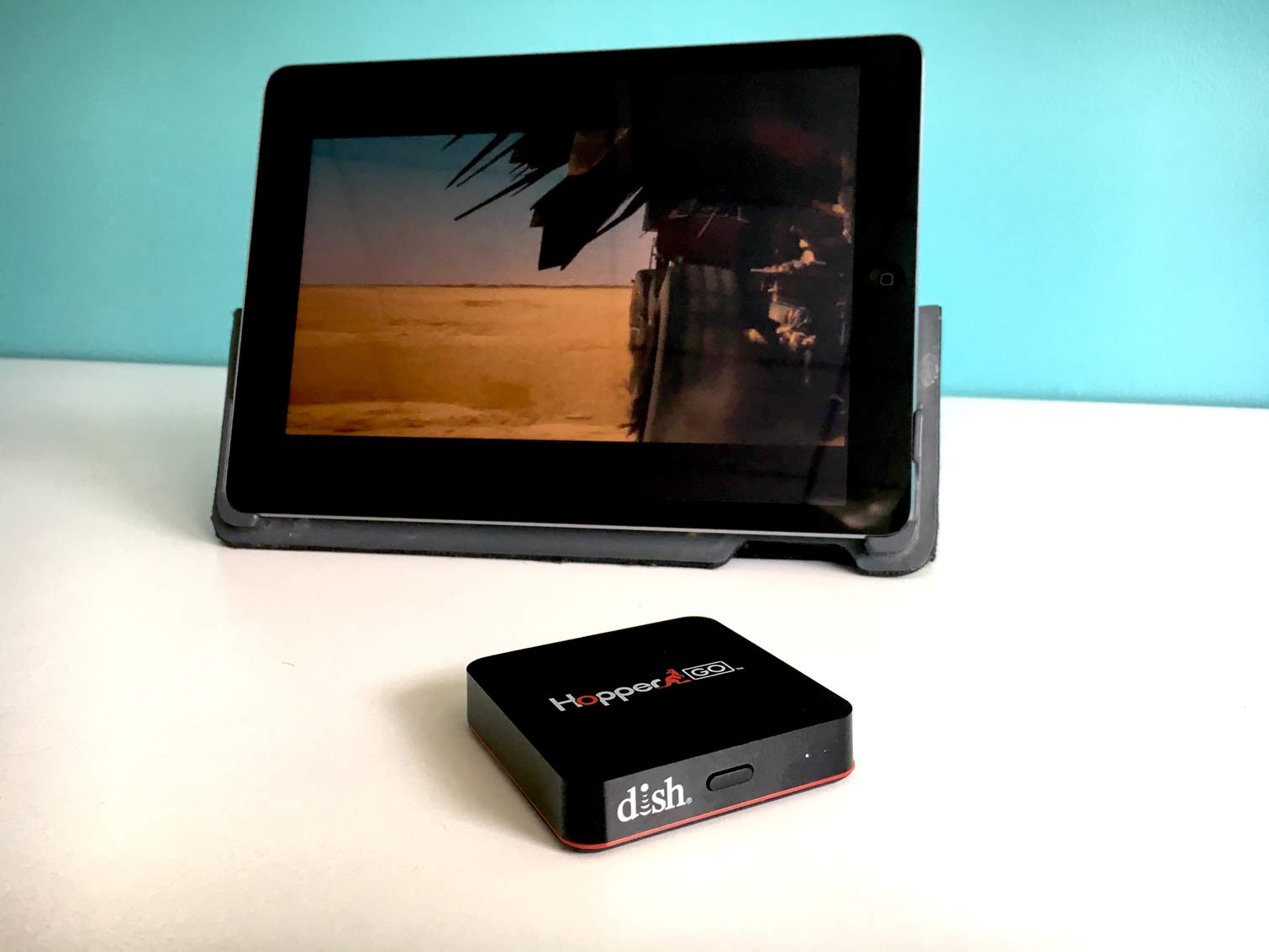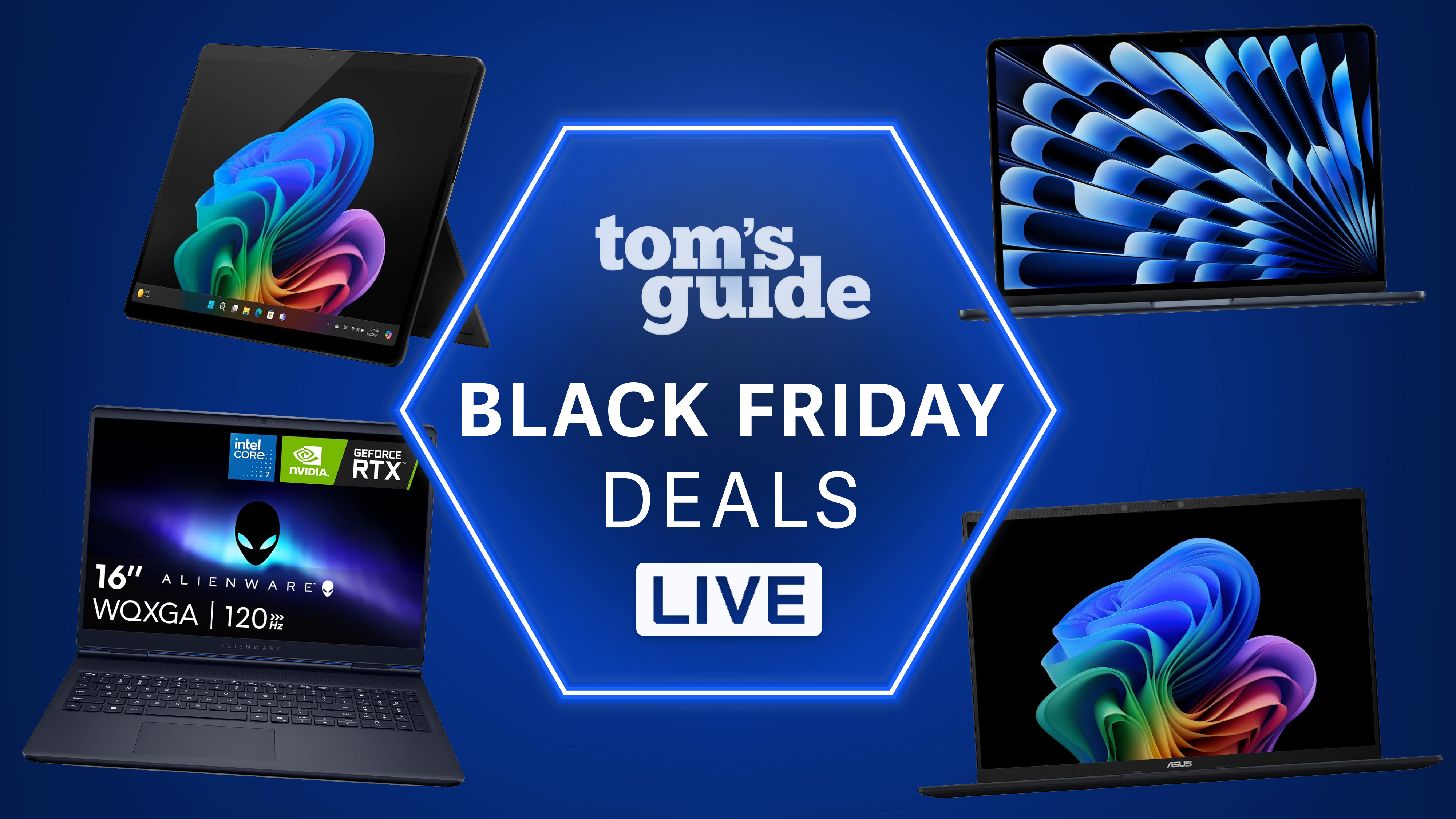Tom's Guide Verdict
This small device lets you take your Dish DVR recordings wherever you go, but it’s not as versatile as other wireless hard drives.
Pros
- +
Small and portable
- +
Lets you stream video to five devices
- +
Stores up to 100 hours of recordings
Cons
- -
Can’t transfer recordings back to DVR from HopperGO
- -
Not all DVR content can be transferred to HopperGO
Why you can trust Tom's Guide
When the movie options on airplanes aren't always the best, and you can't stream Netflix, how are you going to keep yourself entertained? The $99 HopperGO is DishTV's inexpensive answer. This small box can hold up to 100 hours of your DVR recordings, which you can carry with you on a cross-country flight or drive. But unless you've got a ton of saved movies, this isn't the device for you just yet.
Design
The HopperGO is a small black box, not much larger than a matchbox. On the front are two small LEDs that let you know if it's on, next to a power switch.

The back of the box has a micro USB and a full-size USB port; the former is used to charge the Go and transfer content to the device, while the latter is used to copy content off the Go.
MORE: Best Streaming Media Players
At 2.6 x 2.6 x 0.6 inches, I barely noticed the 2.4-ounce HopperGO in my pocket.
Setup
After connecting the HopperGO to your Hopper (the device works with the Dish Hopper 2 and Hopper 3 DVRs), a message will appear on your TV as well as the Hopper Anywhere app indicating that it's plugged in.

When you transfer a recording to the HopperGO (or your iPad), it's removed from your DVR. Unfortunately, there's no way to transfer that file back to your DVR, so if you want to watch it on your TV again, you'll have to re-record it.
Get instant access to breaking news, the hottest reviews, great deals and helpful tips.
Editor's note (5/27): According to Dish, not all content that's transferred to the HopperGO will be removed from your DVR; it all depends on the rights and permissions granted to the content being moved.
To watch videos stored on the HopperGO, you must first connect your tablet or smartphone (Android, iOS, and Kindle) to the GO's built-in Wi-Fi network. Unfortunately, the device doesn't have pass-through Wi-Fi, so while your mobile device is connected to the GO, you won't be connected to the Internet. Seagate has included that feature in its wireless hard drives for years.

You can stream videos to up to five devices simultaneously, but you need to have installed the Dish Anywhere app on those devices and be logged into it. This could be useful if you have multiple tablets and want to keep your kids entertained on a long car ride.
"Copying an HD version of Mad Max: Fury Road (125 minutes) took about 2 to 3 minutes."
The Dish Anywhere app also lets you transfer movies directly to your iPad, but then you won't be able to watch the movies on other devices, such as your phone or laptop.
MORE: Buying a TV? Here Are 11 Things You Should Know
You can also transfer non-DVR content to the HopperGO, such as other movie and music files.
Performance
The HopperGO has 64GB of onboard storage, which Dish says is enough for 100 hours of recordings. To see how much storage has been used, press the Settings icon in the lower right corner of the Dish Anywhere app and select "HopperGO" from the left-hand menu.

Copying an HD version of Mad Max: Fury Road (125 minutes) as well as The Imitation Game to the HopperGO took about 2 to 3 minutes each. However, when I tried copying Whiplash (from Starz) and Stagecoach (from Turner Classic Movies), the GO got stuck on "Preparing."

There are limits to what you can watch on the HopperGO. You can't transfer pay-per-view content or movies or shows you've rented.
MORE: How to Buy a Streaming Media Player
With my iPad connected to my Wi-Fi network, I could see through the Dish Anywhere app what recordings had been transferred to the HopperGO. However, in order to watch those recordings, I had to connect my iPad to the HopperGO's Wi-Fi signal.
"Unfortunately, there's no way to transfer that file back to your DVR, so if you want to watch it on your TV again, you'll have to re-record it."
Streaming movies from the HopperGO to my iPad was quick; it took about 30 seconds to start buffering, but after that, the movies came through clearly, without any lag or artifacts. I was also able to skip forward and back through movies without much lag.
Battery Life
Dish says that the GO's battery will last up to 4 hours when streaming movies to two devices. You can also stream movies while the GO is recharging, which is particularly useful when you're on a long flight.
From a full charge, I streamed a movie to a single iPad, and after 3 hours, the HopperGO was down to 56 percent battery life. On the Dish Anywhere app, a status bar in the upper right corner shows how much juice is left on the HopperGO, though.
Bottom Line
Who says you can't take it with you? The $99 HopperGO is an inexpensive way to watch your DVR recordings when you can't connect to a network, without using up all the storage on your iPad or other tablet. Still, there are some kinks to be worked out: There's no way to tell how much battery life or storage is left on the GO itself, and once you've transferred something from your DVR, there's no way to transfer it back.
If you have a lot of content other than Dish DVR recordings, the Seagate Wireless Mobile Storage is a better option. While you can't load DVR recordings to it, this $89 device has 500GB of storage (for any type of content, such as movies, photos and documents), can beam content to Chromecast, an LG Smart TV or a Roku player, in addition to your tablet, and has pass-through Wi-Fi.
Dish deserves credit for introducing a different way to take your DVR recordings on the road, but the HopperGO needs some refinement.

Michael A. Prospero is the U.S. Editor-in-Chief for Tom’s Guide. He oversees all evergreen content and oversees the Homes, Smart Home, and Fitness/Wearables categories for the site. In his spare time, he also tests out the latest drones, electric scooters, and smart home gadgets, such as video doorbells. Before his tenure at Tom's Guide, he was the Reviews Editor for Laptop Magazine, a reporter at Fast Company, the Times of Trenton, and, many eons back, an intern at George magazine. He received his undergraduate degree from Boston College, where he worked on the campus newspaper The Heights, and then attended the Columbia University school of Journalism. When he’s not testing out the latest running watch, electric scooter, or skiing or training for a marathon, he’s probably using the latest sous vide machine, smoker, or pizza oven, to the delight — or chagrin — of his family.
-
sjshowal56 It does NOT remove files from the DVR under most circumstances. There are a few exceptions to that regarding DRM.Reply
You CAN tell how much battery and how much storage is left on the HopperGO using the settings menu on the DishAnywhere app. -
mprospero @sjshowal56 - I mentioned in the review that you can see the storage and battery life remaining in the Dish Anywhere app. What I meant in the Bottom Line is that you can't see how much juice is left by looking at the HopperGO itself.Reply

